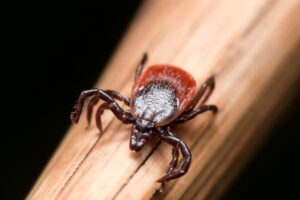
Do ticks jump? If this question has been plaguing you, you aren’t alone. As you consider the pests that can inhabit your home and the surrounding area, you need a solid understanding of how they can impact you–and how far they can move to get to you. Ticks, with their propensity for spreading disease, are a serious concern for many families, especially those that spend lots of time outdoors or that have pets that can bring ticks and other pests inside.
Do Ticks Jump?
Ticks, as it turns out, do not jump at all–so if you’re wondering, “How far do ticks jump?” the answer is, not at all! Ticks are pests that can cause a whole host of problems since their bites can cause anything from mild skin irritation to serious infections with lifelong consequences. However, if you’re considering the question, “How far can a tick jump?” it’s only natural that you would wonder about the construction of a tick’s body and how much distance you might need from a tick in order to prevent it from crawling on you.
Ticks, unlike fleas, do not have the type of body construction necessary to jump. Instead, they have eight legs with short, spiny hairs all over them. At the end, you’ll find tiny, curved claws. These legs are designed to help ticks cling to their target. Once they’re there, they will generally climb upward. If you find a tick on an unexpected part of the body–in your hair, for example — it may have got there by falling from a higher spot, but more times than not or by climbing up your body until it reached its goal.
Can Ticks Fly?
In addition to wondering how far ticks can jump, you may wonder, “Do ticks fly?” Many bugs and insects reach their targets on wings. However, that isn’t the case for ticks! Ticks do not have wings and, therefore, cannot fly to their targets. Instead, ticks are stuck on the ground. However, their spiny legs do enable them to crawl up surfaces, which means that ticks can cover quite a bit of distance when they want to.
How Fast Do Ticks Move?
Generally, the black-legged tick (deer tick) does not move very fast. In fact, they tend to move at a very slow, plodding speed. However, they will often hitch a ride on a faster-moving animal or human to help them get to their destinations. It doesn’t take much for a tick to grasp onto a human or animal target! Those spiny legs are great at clinging to surfaces. While their rear legs hold on to a plant or other surface, the front two pairs of legs will stretch out, waiting for something to brush against them where they can hitch a ride. An example of a fast-moving tick would be the lone star tick, which, once on will find a location to take a blood meal rather quickly. that they can use to move. Once there, of course, they can travel at the speed of the animal or person that is carrying them.
What Can Ticks Feed On?
As you consider how ticks travel, keep in mind that they are most likely to move about on creatures they can feed on. For ticks, that means almost anything: mammals, reptiles, and birds are all fair game for ticks. While they prefer warm-blooded creatures, they’re content with anything that has blood for them to drink. For most ticks located in both Nassau and Suffolk County, a blood meal is needed to complete their reproductive cycle.
Get the Pest Control Services You Need
Whether you have discovered ticks, mosquitoes, or fleas around your property, Mosquito Brothers can help. Contact us today for a free estimate, or call us at 516-321-0606 (Nassau) or 631-440-1881 (Suffolk) to discuss our range of pest control services and the benefits we can offer.
IMG Credit: Steven Ellingson